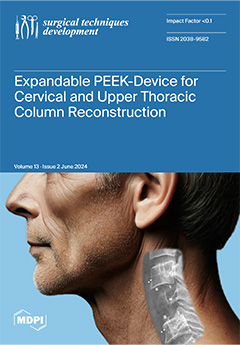Open AccessEditor’s ChoiceArticle
Analysing Pre-Operative Gait Patterns Using Inertial Wearable Sensors: An Observational Study of Participants Undergoing Total Hip and Knee Replacement
by
Pragadesh Natarajan, Ashley Lim Cha Yin, R. Dineth Fonseka, David Abi-Hanna, Kaitlin Rooke, Luke Sy, Monish Maharaj, David Broe, Lianne Koinis and Ralph Jasper Mobbs
Viewed by 1844
Abstract
Background. Knee and hip arthroplasty are two of the most frequently performed procedures in orthopaedic surgery. They are associated with positive patient-reported outcomes and significant improvements in quality of life for patients. Despite this, there may be room for further progress by quantifying
[...] Read more.
Background. Knee and hip arthroplasty are two of the most frequently performed procedures in orthopaedic surgery. They are associated with positive patient-reported outcomes and significant improvements in quality of life for patients. Despite this, there may be room for further progress by quantifying functional improvements with gait analysis. Our study therefore aims to characterise the disease-specific gait pattern of participants with knee and hip osteoarthritis undergoing total joint replacement using a single chest-based wearable sensor. Methods. Twenty-nine participants awaiting total hip replacement and 28 participants awaiting total knee replacement underwent three-dimensional motion analysis with inertial wearable sensors. These gait metrics were then compared with 28 healthy controls of similar ages. Differences in gait metrics were evaluated using a T-test. The participants were recruited through a single centre to participate in this cross-sectional observational study. Participants with osteoarthritis severity sufficient to warrant surgical intervention were considered for inclusion in our study. The participants were instructed to walk 15–120 m in a hospital environment while fitted with a chest-based wearable sensor. Results. In total, three domains were evaluated, including spatiotemporal, variability and asymmetry parameters. There were marked variations in the gait asymmetry parameters and step length variation in both the hip and knee osteoarthritis patients compared with the healthy controls. The magnitude of gait deterioration in terms of step length asymmetry was greater on average in the hip osteoarthritis group than the knee group. The hip osteoarthritis (+180%,
p < 0.001) and knee osteoarthritis (+129%,
p = 0.001) groups demonstrated marked differences in step length asymmetry. Discussion. A single chest-based sensor was found to be capable of detecting pathological gait signatures in osteoarthritis patients when compared with age-matched controls. Future studies should compare pre- and postoperative changes to disease-specific gait impairments to validate the use of wearable sensors as a clinical adjunct.
Full article
►▼
Show Figures




